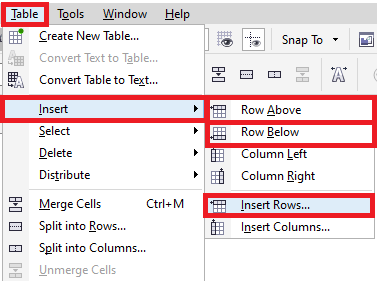Introduction
In the dynamic world of graphic design, CorelDRAW stands as a robust platform, offering designers the tools needed to create visually stunning and well-organized layouts. Understanding how to insert and delete table rows and columns is paramount for achieving flexibility and precision in handling data within your designs. This comprehensive guide navigates through the intricacies of these actions within CorelDRAW, unraveling functionalities, customization options, and the pivotal role they play in enhancing your design projects.
Section 1: Unveiling the Significance of Table Rows and Columns
1.1 Foundational Understanding of Table Structure
Before delving into specifics, it’s crucial to establish a foundational understanding of table structure. Recognize the role that rows and columns play in organizing data within a table, providing a structured and cohesive layout for various design applications.
1.2 Importance of Dynamic Table Adjustments
Explore the significance of dynamic table adjustments. Understanding how to add or remove rows and columns allows designers to adapt layouts on the fly, ensuring the versatility and adaptability of their designs.
Section 2: Accessing Table Adjustment Tools in CorelDRAW
2.1 Locating Table Adjustment Tools
Dive into the CorelDRAW interface to locate the tools for inserting and deleting table rows and columns. Understand where to find options for adjusting, customizing, and managing the structure of your tables based on your design preferences and project specifications.
2.2 Overview of the Table Adjustment Panel
Explore the Table Adjustment Panel and its array of options. Gain insights into the different parameters you can tweak to efficiently insert and delete rows and columns, from basic adjustments to advanced customization.
Section 3: Basic Techniques for Inserting Table Rows and Columns
3.1 Adding Single Rows and Columns
Master the basic techniques for adding individual rows and columns within a table. Learn how to seamlessly expand your table layout to accommodate additional data or design elements.
3.2 Inserting Multiple Rows and Columns
Explore techniques for inserting multiple rows and columns simultaneously. Understand how to use insertion tools to efficiently expand the structure of your table, facilitating the incorporation of extensive datasets.
Section 4: Advanced Customization Options for Insertion
4.1 Adjusting Row and Column Dimensions During Insertion
Delve into advanced customization options for adjusting row and column dimensions during insertion. Learn how to fine-tune the size and spacing of inserted rows and columns, ensuring that the layout remains visually appealing and well-proportioned.
4.2 Applying Preset Insertion Styles
Explore the application of preset insertion styles. Understand how predefined styles can expedite the insertion process, providing a consistent and professional look to your newly added rows and columns.
Section 5: Techniques for Deleting Table Rows and Columns
5.1 Removing Single Rows and Columns
Master the art of deleting individual rows and columns within a table. Learn how to seamlessly streamline your table layout by removing unnecessary elements or restructuring your design.
5.2 Deleting Multiple Rows and Columns
Explore techniques for deleting multiple rows and columns simultaneously. Understand how to efficiently declutter your table by removing selected components, ensuring a clean and well-organized layout.
Section 6: Customizing Deletion Styles and Preferences
6.1 Fine-Tuning Deletion Controls
Master precision controls for fine-tuning deletion. Explore customization options that enable designers to tweak the removal of rows and columns with utmost accuracy, ensuring that every adjustment aligns perfectly with the intended design layout.
6.2 Setting Preferences for Confirmation Prompts
Enhance deletion precision with preferences for confirmation prompts. Learn how to enable features that prompt for confirmation before deleting rows and columns, preventing unintended modifications and providing an additional layer of control.
Section 7: Techniques for Reordering Table Rows and Columns
7.1 Adjusting Row and Column Sequence
Explore techniques for adjusting the sequence of rows and columns within a table. Learn how to effortlessly rearrange the order of components, ensuring a logical and coherent flow in your design layout.
7.2 Swapping Rows and Columns
Master the art of swapping rows and columns. Understand how to interchange the position of specific components, providing flexibility in your design and accommodating changes in data or layout preferences.
Section 8: Incorporating Advanced Table Adjustments
8.1 Dynamic Adjustment of Table Dimensions
Delve into advanced techniques for dynamically adjusting table dimensions. Learn how to resize tables on-the-fly, accommodating evolving design requirements and ensuring a responsive layout.
8.2 Interactive Adjustment for Real-Time Modifications
Explore interactive adjustment techniques for real-time modifications. Understand how making on-the-fly changes to table structure enhances the design process, allowing for immediate feedback and creative exploration.
Section 9: Troubleshooting Common Table Adjustment Issues
9.1 Addressing Unexpected Changes in Dimensions
Navigate through common challenges associated with unexpected changes in dimensions. From misaligned cells to unintended resizing, explore troubleshooting techniques to maintain control and accuracy in your table layouts.
9.2 Resolving Deletion and Insertion Challenges
In case of unintended consequences with deletion and insertion, understand how to troubleshoot and resolve issues. Learn the steps to correct any alterations made in error, ensuring that the integrity of the table layout is preserved.
Section 10: Best Practices for Table Adjustment Mastery
10.1 Efficient Table Adjustment Workflow Strategies
Embrace best practices for an efficient table adjustment workflow. From organizing your workspace to utilizing advanced controls, adopt principles that optimize your design process, enhancing the overall workflow.
10.2 Documentation for Adjustment Conventions
Maintain documentation for adjustment conventions. Explore strategies for documenting specific adjustment configurations and settings, ensuring that the design history is preserved and facilitating collaboration or revisions down the line.
Section 11: Conclusion
In conclusion, mastering the art of inserting and deleting table rows and columns in CorelDRAW is not just about manipulating data; it’s about crafting layouts with flexibility and precision. Embrace the tools, techniques, and considerations discussed in this comprehensive guide, experiment with different adjustment strategies, and elevate your design projects with newfound adaptability and clarity. With table adjustments as your skillset, your creative expressions in CorelDRAW become not only visually striking but also functionally dynamic, setting the stage for design excellence.
